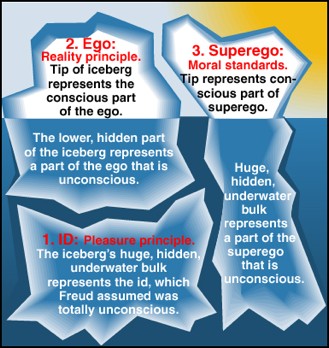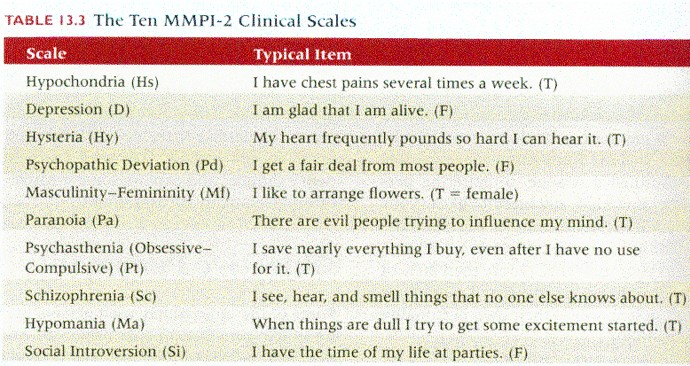Cards In This Set
| Front | Back |
|
How does Freud define
personality? What is psychoanalysis and what are some of the psychoanalytic techniques
used by Freud?
|
- personality reflects conflicting forces within the individual, including some that the individual may not consciously recognize
-can be used to uncover the and interpret the unconscious Freud used: HYPNOSIS, FREE ASSOCIATION, DREAM ANALYSIS, FREUDIAN SLIPS |
|
According to Freud, what
are the three fundamental components of personality, and what are their
characteristics?
|
 Id- unconscious drives for immediate pleasure super ego- learned rules for appropriate social behavior (conscience) ego- rational decision-making center that balances the id and super ego |
|
According to Freud, what
are the five psychosexual stages of personality development?
What are some of the problems that arise when someone fails to resolve
the conflict from one of these stages?
(i.e., oral or anal fixation, Oedipus complex, etc.)
|
1. Oral- sucking, biting2. Anal- bowel and bladder elimination3. Phallic- pleasure zone in genital4. Latency- dormant sexual feelings5. Genital- maturation
* unresolved conflict of fixation to any one of the stage can lead to maladaptive behavior in adulthood |
|
According to Freud, what is
a defense mechanism? What are the 7 mechanisms we
discussed? If I gave you an
example of a specific behavior, you should be able to identify the defense mechanism
it illustrates.
|
- the ego's attempt to reduce anxiety arising from conflicts between the id and super ego.
1. REPRESSION: suppressing undesirable thoughts2. REGRESSION: returning to a more juvenile level to escape responsibility3. REACTION FORMATION: presenting oneself as the opposite as what one really is4. PROJECTION: attributing your undesirable characteristics to people5. RATIONALIZATION: attempting to prove that actions are justifiable6. DISPLACEMENT: diverting a behavior or thought from its natural target to a less threatening one7. DENIAL: refusing to believe information that makes you anxious. |
|
How do modern psychologists
view most of Freud’s theories? Why
are his theories not considered scientific? Of the theories that have been tested, what does the evidence
suggest? Is there much scientific
evidence for repression, for
example?
|
- Freud = untestable theories (non-falsifiable) - people focus more on loftier motives and social interactions- more emphasis on the conscious mind
|
|
How does modern
psychodynamic theory differ from Freud’s ideas?
|
- modern psychodynamic theory does diagnose people as oral or anal based on their behavior as a adult. Instead, both theories agree that a great deal of our mental life in unconscious, and we often struggle with inner conflicts among our wishes, fears, values, and that childhood shapes our personality and ways of being attached to others.
|
|
What is a projective (or implicit) test and what are two examples? Are these tests reliable and valid? Why or why not?
|
- tests that use ambiguous stimuli to trigger projection of one's inner dynamics
Thematic Apperception Test (TAT)Rorscharch Inkblot Test - lack of reliability and validity - results are inconsistent. |
|
What is the humanistic
perspective on personality? What does it focus on? What is meant by
self-actualization, self-concept, self-esteem, and the self-serving bias? (did not go over in lecture)
|
Focuses on the positive image of what it means to be human. Human nature is viewed as basically good, and humanistic theorists focus on methods that allow fulfillment of potential.
- self-concept- all our thoughts and feelings about ourselves, in answering "Who am I?" - self-actualization- the ultimate psychological needs are arise after basic physical and psychological needs are met and self-esteem is achieved; the motivation to fulfill one's potential (we are all acorns) |
|
What are the limitations of
humanistic theory?
|
It is naive.
not all people are nice and happy. some people born evil...? |
|
What is the trait theory of personality? What are the Big 5, (OCEAN or CANOE) and what statistical procedure did researchers use to
identify them? What are the characteristics of these 5 personality traits, and
how do psychologists measure them?
|
- belief that people have consistent personalities- GOAL: to identify a relatively small # os basic traits that can be used to describe everyone!!!! The BIG 5: N. E. O. A. C. -NEUROTICISM- emotional stability- EXTRAVERSION - OPENESS to EXPERIENCE- AGREEABLNESS- CONSCIENTIOUSNESS
use: set of "rating" type questions. Myer Briggs Indicator, Minnesota Personality Inventory (MMPI) |
|
How stable are personality
traits over time? Are there any
noticeable changes that occur in personality as we get older?
|
Fairly stable. especially adulthood.
- NEO- decrease at you get olderAC- tend to increase with age |
|
To what extent are personality
characteristics genetically inherited?
(What type of study is used to determine heritability?)
|
0.5 correlation
- use TWIN studies! :) |
|
Are personality traits,
such as the Big 5 useful in predicting other personal attributes?
|
High C+O- positive school perfromancelow A+C - juvilelle delinquethigh N, low C- internalizing disorders
|
|
What is the MMPI and what is it used for? How does it screen out people who may be lying?
|
 - assesses abnormal personality traits |
|
What are some of the
limitations of trait theory? In
particular, what are some of the problems associated with measuring
traits?
|
- we don't know if people are able to describe themselves accurately - how do we prevent lying?
|



